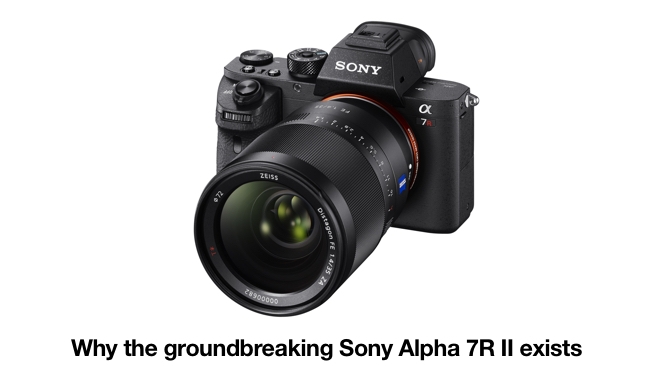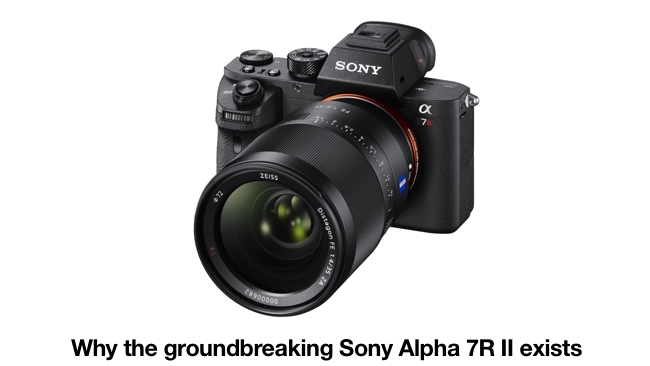
 Why the A7R II exists
Why the A7R II exists
Sony's new 4K recording Alpha 7R Mk II surprised everyone. Here's why it exists.
Just when I thought I was going to have a quiet weekend, the news dropped that Sony had revealed three new cameras that were so unexpected that they took me and all my professional colleagues totally by surprise. We weren't just amazed that there were three new cameras, but that their specifications were so good as well. We didn't expect these cameras just now, nor for them to have such extraordinary capabilities.
We don't just mean 4K here. We mean new sensors with a new architecture, designed to eliminate several of the problems that have bugged DSLRs and - to some extent - mirroress cameras too.
Bigger sensors, with sensitivity, and more data bandwidth, to move 4K (and even greater than 8K for stills) around faster than ever before. 399 point autofocus and five axis in-body stabilisation (worth up to 4.5 additional stops) make a pretty potent mix.
Overall, we're staggered by Sony's speed in effectively dominating this market. They've come from almost nowhere in little over four years. We're accustomed to depth and quality from Japanese companies, but with a methodical approach that verges on perfectionism, not speed and adaptability in a rapidly changing market landscape.
And yet, this is exactly what we've witnessed over the last few years and especially the last year and a half. Starting with the low light champion, the A7S, we've seen a strategic approach that can't be faulted, and which is proving to be a very good thing for consumers.
In any creative endeavour, there's always one thing that's so important that if you don't do it, or it isn't good enough, then it's not worth doing anything at all: one thing that you just have to get right. I've been talking to product managers and engineers at Sony recently and the consistent (and quite spontaneous) message that I get from them is that it's the image that matters above all else. This is the case across consumer and professional products; still and video cameras.
Not many companies are in the same position as Sony when it comes to the ability to chase down good images, because they don't just make cameras - they make their own sensors too. Which means that almost down to the molecular level, they can determine how their sensors are going to work. We'll be bringing you more details about Sony's new Exmor RS sensors in other articles but the standout features are that they feature back illumination (which I think would be less confusing if it was called "front Illumination") and a much faster data bandwidth.
A new sensor architecture
Back illumination means that the electronic interconnects between the parts of the sensor are moved towards the rear of the component, freeing up space for the light-sensing elements (the photosites) and the lenses. The result is greater light sensitivity, less noise, and an overall better picture.
By changing the "wiring" in the sensor from aluminium to copper (which is a better conductor), Sony has increased the data speeds to the extent that "Rolling Shutter" may have been nearly eliminated. (Note that we're making an assumption here. Sony did not mention Rolling Shutter specifically. The closest they came to doing so was when they said that diagonal distortion caused by moving the camera (or moving objects within a still scene) was almost invisible.)
In addition, there's a layer of high speed signal processing just behind the pixel plane, and a DRAM chip (memory) Just under this. This new architecture adds up on faster data, higher frame rates (up to 1000fps - but only at lower resolutions. 1080p is possible at up to 250 fps: similar to an FS700). It is this high speed readout that has the potential to reduce rolling shutter to negligible proportions.
There's an important point to mention here. The A7S has been phenomenally popular as the first full frame camera to output (but not record internally) 4K without pixel binning. This remains the case with the release of the A7R II. The sensor in the newer camera was, it seems, optimised around the aim of outputting a cropped Super 35mm sensor area without pixel binning, with even this smaller area benefiting from supersampling from more pixels than are needed for 4K. This means that, once the video from the sensor is deBayered, the result is a true 4K image, as opposed to cameras where exactly 4K pixels are used as a source, which would mean that the deBayered image is less than true 4K.
If you want a full frame image from the A7R II, you will have to accept pixel binning. Presumably 42 megapixels is just too great a number for the camera's processor to downsample from in real time at 60 fps. But this doesn't mean there will be anything wrong with the images, because it all depends on how Sony handles the binning from this huge number of pixels in the first place, and there's every chance that they will have found a good way to do this. So, to sum up, as Sony told me themselves: if you want internal recording of 4K, buy an A7R II and use it optimally in S35 mode for a true, supersampled 4K output. If you want a full frame supersampled 4K, buy an A7S.
While I was talking to the A7R II product managers recently at a special press event at Pinewood Studios, I mentioned that it now looks like consumer technology tends to trickle up from consumer products, and not the other way round, perhaps like in Formula one. In other words - the advanced stuff is appearing in the consumer markets before it emerges in professional equipment. But it turned out I wasn't quite right about this. Here's why.
Sony's flagship movie camera is the F65. It's a beast. With a 20 megapixel sensor, when it came out in 2012, it was like nothing else. It's still being very successfully used on high end films and I've even heard recently that some directors are specifying vintage lenses to use with it because it is so clean and detailed that it captures every nuance of an old lens's character.
It seems that the sensor technology in this top end camera has to some extent informed the team developing the new imagers for the latest Sony devices, which in turn, are so good that professionals will be clamouring to use them.
Apparently the success of the A7S as a video tool has inspired Sony's product strategists to call for more cameras with outstanding video capabilities. It seems to be a winning formula: still cameras optimised for capturing video.
And so we have a kind of parabolic curve in the development of these cameras: from the high end to the low end, and then back to the mid end.
But there's another curve that's becoming apparent here: an exponential one. It's the one that is characterised by Moore's law, and by the multiplicative effect of mutually beneficial technologies. What it means is that technology is improving and that the rate of improvement is increasing. We've often said that, soon, change will be so fast that we won't be able to predict it. New and dramatically improved products will appear suddenly, with no warning.
That's exactly what happened with the A7R II.
Tags: Production


Comments